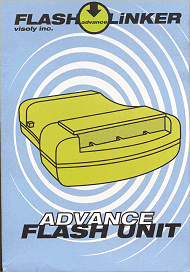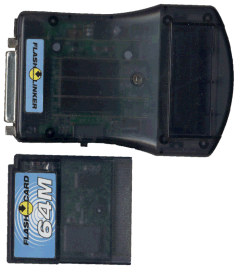GBA FlashLink
4. Hardware Inspection
Review Pages
Flash Advance Linker and Card - Page 4
Hardware Inspection
Physical Examination :
Having tested all points and aspects of the base platform, the Gameboy Advance,
we will move on to examine the main course of this review. The Gameboy Advance
Flash Linker and Card.
Package:
 The
package that arrived for testing was the retail version. Inside the boxes we
found the devices, which were held in place by a plastic casing. Also included
was a very brief leaflet, explaining most of the functions. A minor dissapointment
was that the documentation was only in English and Chinese. We noticed that
the manual had 'Instruction Manual Version 1.00' printed on the front page,
so we should probably be expecting revised versions.
The
package that arrived for testing was the retail version. Inside the boxes we
found the devices, which were held in place by a plastic casing. Also included
was a very brief leaflet, explaining most of the functions. A minor dissapointment
was that the documentation was only in English and Chinese. We noticed that
the manual had 'Instruction Manual Version 1.00' printed on the front page,
so we should probably be expecting revised versions.
Inside the Flash Linker box we also found a 1.44" floppy disk. It had no label, and contained the necessary software for the PC, used in order to communicate with the parallel port and download/ upload games to the Flash Card. This software is called 'Flash Advance Writer', and it is also available for download at the company website.
 The envelope also contained a DB25-to-DB25 cable for connecting the Flash Linker
to the parallel port of a PC.
The envelope also contained a DB25-to-DB25 cable for connecting the Flash Linker
to the parallel port of a PC.
Let's look at the manual and read about what those two devices are supposed to do:
"Flash Advance Linker can be used to transfer data to Flash Advance Card by connecting to a PC via a 25-pins printer extension cable (both ends of cable must be male). Insert the Flash Advance Card into the Flash Advance Linker cartridge slot to receive data from PC. After data have been transferred into the Flash Advance Card, remove the card and insert it into the Gameboy Advance cartridge and power on. The supplied software, Flash Advance Writer, works flawlessly with Windows 95, Windows 98, Windows ME, Windows 2000 and also Windows NT (using additional software)."
 As
you can see on the photos, both the Linker and the Card have a cool transparent
blue casing. Due to this we were able to see most of the parts that were inside.
But as an attempt to justify our title of 'ruthless hardcore reviewers that
snoop inside everything', we decided to unscrew the shells and have a thorough
look inside. All of our findings were satisfactory. Soldering joints were of
excellent quality and the whole design is based on custom ICs. The casing of
both devices seems rugged and of good quality. It is probably able to withstand
years and years of punishment. As for the battery on the Flash Card, its expected
life span is well over 5 years, and it is also a common type and replaceable
one. We just couldn't help putting our thumbs up for the project engineers that
designed these babies.
As
you can see on the photos, both the Linker and the Card have a cool transparent
blue casing. Due to this we were able to see most of the parts that were inside.
But as an attempt to justify our title of 'ruthless hardcore reviewers that
snoop inside everything', we decided to unscrew the shells and have a thorough
look inside. All of our findings were satisfactory. Soldering joints were of
excellent quality and the whole design is based on custom ICs. The casing of
both devices seems rugged and of good quality. It is probably able to withstand
years and years of punishment. As for the battery on the Flash Card, its expected
life span is well over 5 years, and it is also a common type and replaceable
one. We just couldn't help putting our thumbs up for the project engineers that
designed these babies.
 The
only thing that we didn't like during the physical examination of the two devices
was the shape of the Flash Card. It has the shape of a Gameboy cartridge, and
not that of a GBA game. As a result, when you plug it in the console it sticks
out in an awkward manner. Fortunately the Flash Card that we reviewed was an
older model one, and as we were told pretty soon all the future Cards will be
produced at the appropriate shape and size.
The
only thing that we didn't like during the physical examination of the two devices
was the shape of the Flash Card. It has the shape of a Gameboy cartridge, and
not that of a GBA game. As a result, when you plug it in the console it sticks
out in an awkward manner. Fortunately the Flash Card that we reviewed was an
older model one, and as we were told pretty soon all the future Cards will be
produced at the appropriate shape and size.
 In
order to make this review a detailed as well as an interesting one, we decided
to compare the Flash Advance Linker and Card with a similar but a bit older
system. It is the GBXChanger and GB Flash Card, manufactured by Bung for the
Gameboy Color. For those of you who don't know, Bung was forced to close down
due to a lawsuit by Nintendo in the year 2000. So the GBXchanger and its cards
are not available anywhere for sale anymore.
In
order to make this review a detailed as well as an interesting one, we decided
to compare the Flash Advance Linker and Card with a similar but a bit older
system. It is the GBXChanger and GB Flash Card, manufactured by Bung for the
Gameboy Color. For those of you who don't know, Bung was forced to close down
due to a lawsuit by Nintendo in the year 2000. So the GBXchanger and its cards
are not available anywhere for sale anymore.
Review Pages













